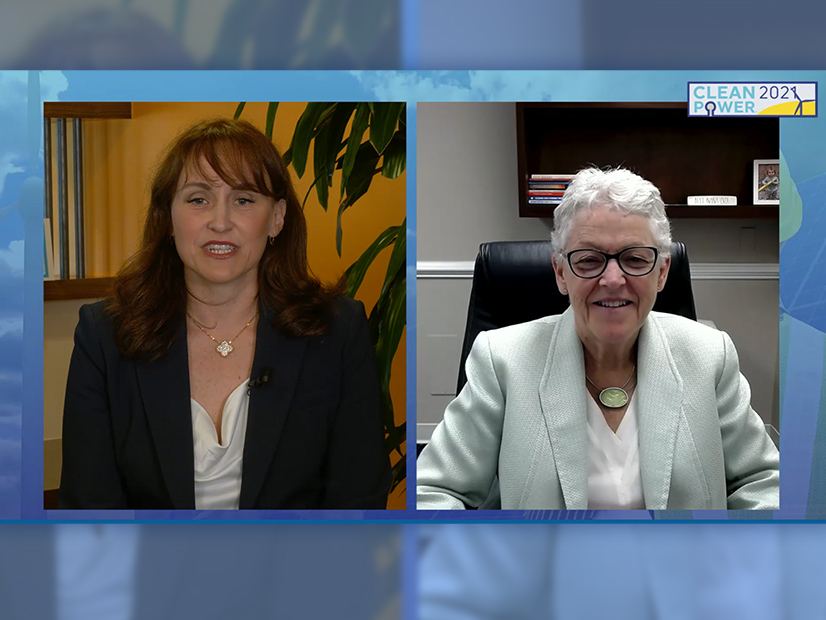Unity was the theme at the opening session of the American Clean Power Association’s (ACP) Clean Power 2021 conference Monday, the first by the group since its launch in February, replacing the American Wind Energy Association (AWEA).
Gina McCarthy, who headed the Environmental Protection Agency during the Obama administration and now heads the White House Office of Domestic Climate Policy, said the Biden administration’s “early wins” with offshore wind were evidence of its coordination and cooperation to address climate change.
“Our climate policy office in the White House has been very focused — not just on a couple of agencies, but on the 31 agencies that have been tasked [to factor] in climate in everything that they do,” she said. “Every cabinet member knows that they’re responsible to work together to actually make these partnerships happen.”
On May 11, the Bureau of Ocean Energy Management (BOEM) gave final approval to Vineyard Wind, the nation’s first commercial-scale offshore wind project. Two weeks days later, BOEM announced it would offer leases for as much as 4.6 GW of offshore wind off the California coast, where the Pentagon conducts training exercises. (See BOEM to Offer Leases for Calif. Offshore Wind.)
“And that was all brought about because the Department of Defense was brought to the table and asked to open up opportunities in a way that their security interests would be protected but our ability for offshore off of the coast of California would be able to get started,” McCarthy said.
She also said interagency working groups are studying transmission issues “so that we can work together and identify where the opportunities are and where the [obstacles are].”
Tax credits to incentivize renewables are not enough, she said. “We have to know that we have a system in place that can quickly make the grid a system that works and accesses renewables everywhere” and that individual projects can get permitted.
“That’s going to take the kind of coordination that our policy office was created to do. And so far, so good. We have fabulous cabinet members; I’m not seeing tensions between them. They’re working hand in hand. They’re combining their resources to move projects forward.”
AWEA Successor Seeks Increased Clout by Merging Wind, Solar, Storage Advocacy

Mike Garland, CEO of renewable energy developer Pattern Energy, followed McCarthy by recounting how AWEA decided to rename itself and broaden its advocacy efforts to include solar and storage.
“About five years or so ago, a number of us in the renewable industry kept talking about how we were punching under our weight and that blended solar and storage had more in common on policies and regulations and other things that we should be working closer together on,” he said. “And … we were getting feedback from legislators as well as some decision-makers about how there was inconsistency; they were hearing different things from different parts of the industry, and that was sending mixed messages on how to present a policy program that would be more supportive of the renewable industry.”
Garland said he and other AWEA members took note that AWEA’s $22 million in revenue, combined with the Solar Energy Industries Association’s (SEIA) $16 million, were dwarfed by the American Petroleum Institute and Edison Electric Institute, which had revenues of more than $100 million each.
“We didn’t have the … resources to compete against fossil [energy] associations that were lobbying on their behalf,” he said. “We were much more disjointed. The fossil industry had like 25 organizations representing it, and renewables had 53 organizations, so it was really a disaggregated set of players. We also looked at the fact that wind and solar were most active in different states, and if we combined our effort, we’d double — or even more — the number of states that we’d have influence in.”
That led to AWEA and SEIA to pledge closer coordination on policy and, in February, AWEA’s transformation into ACP. Although the new organization includes solar industry players among its members, SEIA ultimately decided to remain independent.

ACP set a goal of $60 million in revenues by the end of its first year, with eventual growth to at least $90 million, Garland said.
“I estimate about 75% of all new renewable [energy] is represented by ACP. So that’s a hell of a start,” he continued. “Seventy-five percent of the hardware going on the ground and over buildings and over parking lots and other things is being provided by people that are part of ACP.”
Al Vickers, CEO of BP Wind Energy, said ACP’s broader focus makes sense.
“I actually think it’s super important that we find our common ground and draw strength from our diversity rather than allowing the potential differences that we may have as different … sectors of the clean power industry be something that divides us. I think we should find the things that unite us,” he said.



